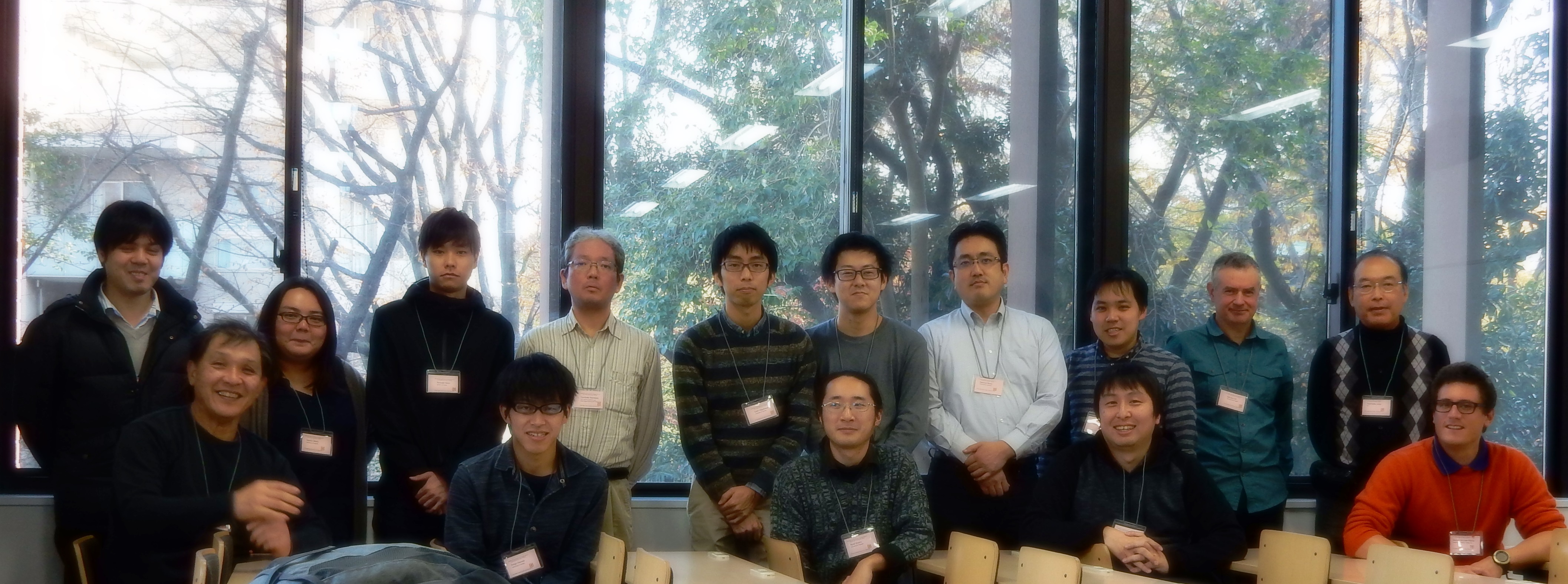


Workshop for Development and Applications of Fast-Timing Semiconductor Devices
December 8, 2018 at University of Tsukuba (Tokyo Campus) poster
program
indico page
The workshop for discussing development and applications of fast-timing semiconductor devices was held on December 8th, 2018 at University of Tsukuba, Tokyo Campus. 18 participants including four from abroad institutions discussed on the topics frankly, thanks to relatively small workshop of this kind, for 9 contribution talks.
The workshop was started by Kazuhiko Hara (U Tsukuba), welcome address and introduction, briefly summarising the history of fast-timing device development.
First three talks were presented by master-course students. Kyoji Onaru (U Tsukuba) reported gain and unifromity measurements for pad-type and strip-type LGAD (low-gain avalance detector) fabricated by Hamamatsu Photonics including radiation damage study. Sayaka Wada (U Tsukuba) reported on timing measurement using 120 GeV protons, showing 28 ps timing resolution achieved using 5GS/s flash ADCs, and study of timing measurement techniques other than Flash ADC. Ryosuke Mori (Kyushu U) talked about inverse-LGAD as a timing detector to separate K/pi at ILC experiment and reported on initial evaluation of inverse-APD read out with SKIROC ASIC developed for ILC Ecal.
Next two talks were time-of-flight ToF-PET presented first by Taiga Yamaya (NIRS/QST) detailing the ToF-PET system developments at NIRS, depth-of-interaction detector (DOI-PET) and detection of Compton (WGI- whole gamma imaging), and also addressing points of consideration in semiconductor devices application to the PET. Daiki Hayakawa (U Geneva) then presented their ToF-PET system based on stacks of thin pixel+converter layers with SiGe biCMOS low noise amplifiers and first timing eveluation performed using CERN PS test beam.
During Daiki's presentation, we all (Daiki later after his presentation!) enjoyed lunch bento purchased at Origin Bento Ship near Myogadani station. Daigo Harada (U Tsukuba) is aprreciated for collecting individual menu preferences and fetching bentos to the workshop room.
Sayaka Wada, 2nd talk, presented her study based on TCAD simulation. The simulation parameters, verified through comparison to the measurement results (Kyoji's presentation), are being adopted in the simulations for new strip isolation based on deep trench and AC-LGAD for better "fill fator" realization.
Adriano Lai (U Cagliari) presented TIMESPOT project, using 3D sensors optimzed for timing with deep trench as electrodes. On-going design of fast electronics (aiming at 20ps timing and for pixels of 50 micron-square) is introduced.
Importance of fast-timing was addressed by Masahiko Saito (U Tokyo) at FCC, future circular collider, to look for new heavy particles prediced in SUSY by detecting disaaperaing short tracks where fast-timing is effective in reducing the background and measuring velocity of heavy particles.
Last of the contribution was by Simone Mazza (UCSC) describing the detector development for the ATLAS HGTD (high granularity timing detector) at HL-LHC, first approved detector using LGAD. Evaulation results were detailed on HPK and FBK sensors with 50 and 35 um active thicknesses and on BNL AC-LGAD. Test beam results were also presented using ATLTIROC readout system for pad-array detector.
The workshop was concluded by Koji Nakamura (KEK) summarizing the main conclusions/implications/difficulties presented and discussed during the workshop, hoping another workshop organized in near future.
Photos (sorry, just a few were taken)
Workshop photo
PET (Yamaya-san)
3D sensor and fast electronics by Adriano Lai)
The workshop was organized by Kazuhiko Hara (U Tsukuba), Koji Nakamura (KEK) and Yoshinobu Unno (KEK) supported by Japan-US Science and Technology Corporation Program and Tomonaga Center for the History of the Universe at University of Tsukuba.
Tokyo Campus of Univerisity of Tsukuba used to be the main campus of Tokyo Univeristy of Education, the formar of University of Tsukuba.